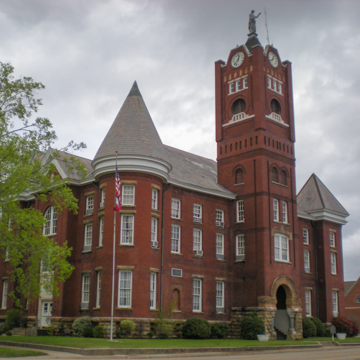The town of Newport was named for what it was—a new port on the White River—but its growth came when the Cairo and Fulton Railroad (later the Missouri Pacific) came through in 1873. By 1880 Newport surpassed the county seat, Jacksonport, in population, and the issue of moving the courthouse was first considered. It took until 1891 for the move to be approved because the fine large courthouse (see JA1) at Jacksonport had only been completed in 1872. Newport’s courthouse is a striking three-story building, rather awkward in its proportions and mostly Richardsonian Romanesque in style. It is built of red brick on a rusticated buff-colored stone foundation and has a tower on each corner. Two towers are square with pyramidal roofs, and two are round, one with a conical roof and the other with a tall hipped roof. The towers add a Chateauesque flavor to the courthouse, but dominating the building is a fifth tower. Six stories in height, this clock tower rises above the entrance and is topped with a statue of Justice. The building’s entrance at the tower’s base is round arched and flanked by squat stone columns. The courthouse was not provided with a central courthouse square, but it was nevertheless the center of the business district. In 1939, a one-story, matching brick annex was added on the north side when other renovations were also done.
You are here
Jackson County Courthouse
If SAH Archipedia has been useful to you, please consider supporting it.
SAH Archipedia tells the story of the United States through its buildings, landscapes, and cities. This freely available resource empowers the public with authoritative knowledge that deepens their understanding and appreciation of the built environment. But the Society of Architectural Historians, which created SAH Archipedia with University of Virginia Press, needs your support to maintain the high-caliber research, writing, photography, cartography, editing, design, and programming that make SAH Archipedia a trusted online resource available to all who value the history of place, heritage tourism, and learning.


